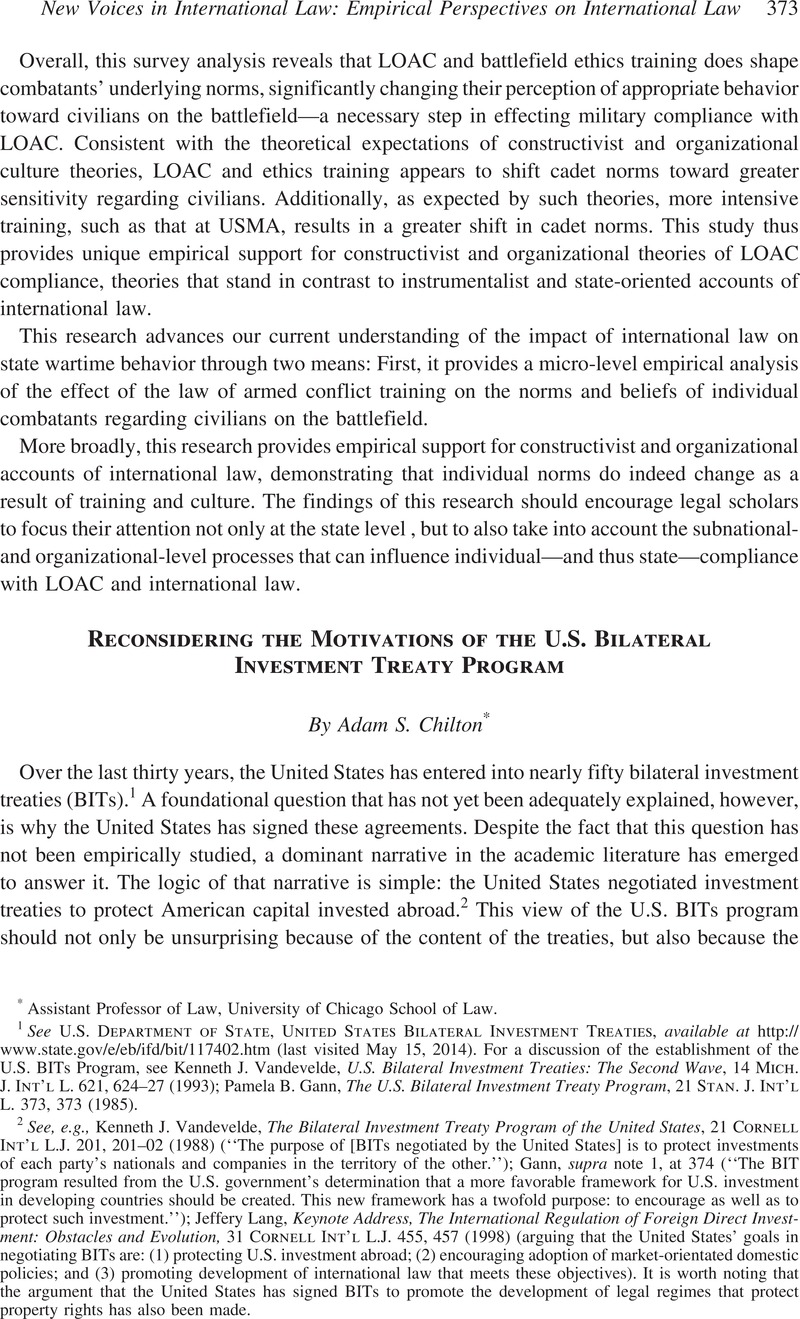No CrossRef data available.
Article contents
Reconsidering the Motivations of the U.S. Bilateral Investment Treaty Program
Published online by Cambridge University Press: 20 January 2017
Abstract

- Type
- New Voices in International Law: Empirical Perspectives on International Law
- Information
- Copyright
- Copyright © American Society of International Law 2015
References
1 See U.S. Department of State, United States Bilateral Investment Treaties, available at http://www.state.gov/e/eb/ifd/bit/117402.htm (last visited May 15, 2014). For a discussion of the establishment of the U.S. BITs Program, see Vandevelde, Kenneth J., U.S. Bilateral Investment Treaties: The Second Wave, 14 Mich. J. Int’l L. 621, 624–27 (1993)Google Scholar; Gann, Pamela B., The U.S. Bilateral Investment Treaty Program, 21 Stan. J. Int’l L. 373, 373 (1985)Google Scholar.
2 See, e.g., Vandevelde, Kenneth J., The Bilateral Investment Treaty Program of the United States, 21 Cornell Int’l L.J. 201, 201–02 (1988)Google Scholar (“The purpose of [BITs negotiated by the United States] is to protect investments of each party’s nationals and companies in the territory of the other.”); Gann, supra note 1, at 374 (“The BIT program resulted from the U.S. government’s determination that a more favorable framework for U.S. investment in developing countries should be created. This new framework has a twofold purpose: to encourage as well as to protect such investment.”); Lang, Jeffery, Keynote Address, The International Regulation of Foreign Direct Investment: Obstacles and Evolution, 31 Cornell Int’l L.J. 455, 457 (1998)Google Scholar (arguing that the United States’ goals in negotiating BITs are: (1) protecting U.S. investment abroad; (2) encouraging adoption of market-orientated domestic policies; and (3) promoting development of international law that meets these objectives). It is worth noting that the argument that the United States has signed BITs to promote the development of legal regimes that protect property rights has also been made.
3 Tobin, Jennifer L. & Busch, Marc L., A BIT is Better Than a Lot: Bilateral Investment Treaties and Preferential Trade Agreements, 62 World Pol. 1, 2 (2010)CrossRefGoogle Scholar (“Wealthy states want BITs as an institutional check against uncompensated expropriation”); Salacuse, Jeswald W., BIT by BIT: The Growth of Bilateral Investment Treaties and Their Impact on Investment in Developing Countries, 24 Int’l Law. 655, 661 (1990)Google Scholar (“[Developed states’] primary objective has been to create clear international legal rules and effective enforcement mechanisms to protect investment by their nationals in the territories of foreign states.”).
4 Despite its relevance, this topic has been almost entirely ignored in the academic literature. But see Kenneth J. Vandevelde, U.S. International Investment Agreements 26 (2009).
5 Id. at 26.
6 See Peinhardt, Clint & Allee, Todd, Failure to Deliver: The Investment Effects of U.S. Preferential Economic Agreements, 35 World Econ. 757 (2012)CrossRefGoogle Scholar.
7 Another piece of evidence against an investment-centric view of BIT formation is recent scholarship suggesting that BITs do not appear to influence the decisions of companies or insurance companies. See Yackee, Jason Webb, Do Bilateral Investment Treaties Promote Foreign Direct Investment? Some Hints from Alternative Evidence, 51 Va. J. Int’l L. 397 (2010)Google Scholar.
8 It is worth noting that the motivations behind current BIT negotiations—like the one with China—may be different.
9 See Table 1.
10 Bilateral Investment Treaties Treaty Doc. 99-14 and Treaty Doc. 101-18: Hearing Before the Senate Committee on Foreign Relations, 101st Cong. 11 (1990) (testimony of Eugene J. McAllister, Assistant Secretary for Economic and Business Affairs, Department of State).
11 Id.




